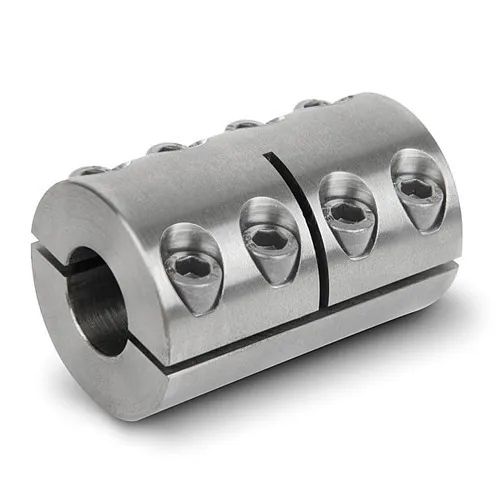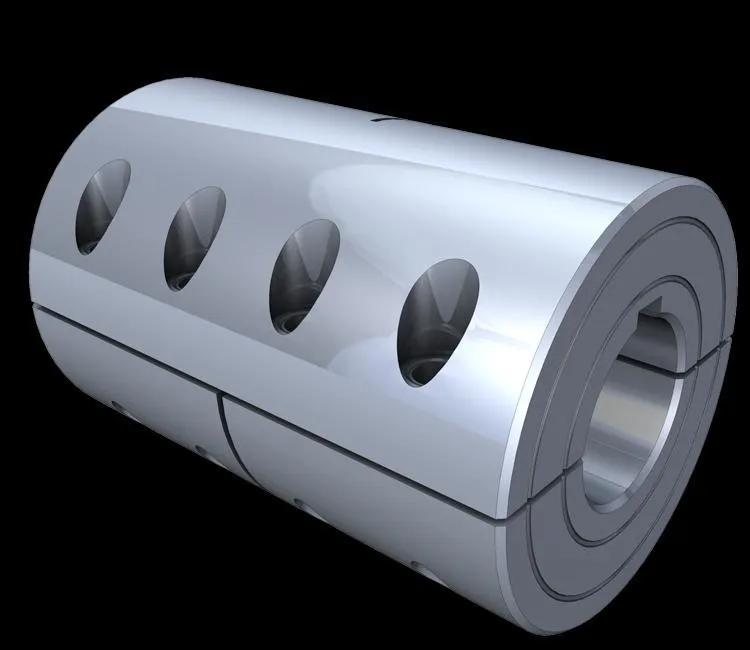Product Description
Stainless Steel Gear Roller Chain Mechanical Power Transmission Drive Parts Components Connection Tyre Grid Jaw Spider Fan Pump Rubber Coupler Manufacturer Round Motor Shaft Price Universal Joint Coupling
Features
1. Compact designing, easy installation.
2. Convenient maintenance, small size, and lightweight.
3. Absorb the transmission of impact load.
4. Prevent overload.
We can provide the following couplings:
| Rigid coupling | Flange coupling | Oldham coupling |
| Chain Coupling | HRC Coupling | Jaw Coupling |
| Sleeve or muff coupling | Gear coupling | Bellow coupling |
| Split muff coupling | Flexible coupling | Fluid coupling |
| Spacer Coupling | Nm Coupling | MH Coupling |
| Clamp or split-muff or compression coupling | Universal coupling | Variable speed coupling |
| Bushed pin-type coupling | Diaphragm coupling | Constant speed coupling |
Product Description
| SIZE | N.m | r/min |
D | D1 | d1 | L | C | n-M | kg | |
| FCL90 | 4 | 4000 | 90 | 35.5 | 11 | 28 | 3 | 4-M8 | 1.7 | |
| FCL100 | 10 | 4000 | 100 | 40 | 11 | 35.5 | 3 | 4-M10 | 2.3 | |
| FCL112 | 16 | 4000 | 112 | 45 | 13 | 40 | 3 | 4-M10 | 2.8 | |
| FCL125 | 25 | 4000 | 125 | 65 | 50 | 13 | 45 | 3 | 4-M12 | 4 |
| FCL140 | 50 | 4000 | 140 | 71 | 63 | 13 | 50 | 3 | 6-M12 | 5.4 |
| FCL160 | 110 | 4000 | 160 | 80 | 15 | 56 | 3 | 8-M12 | 8 | |
| FCL180 | 157 | 3500 | 180 | 90 | 15 | 63 | 3 | 8-M12 | 10.5 | |
| FCL200 | 245 | 3200 | 200 | 100 | 21 | 71 | 4 | 8-M20 | 16.2 | |
| FCL224 | 392 | 2850 | 224 | 112 | 21 | 80 | 4 | 8-M20 | 21.3 | |
| FCL250 | 618 | 2550 | 250 | 125 | 25 | 90 | 4 | 8-M24 | 31.6 | |
| FCL280 | 980 | 2300 | 280 | 140 | 34 | 100 | 4 | 8-M24 | 44 | |
| FCL315 | 1568 | 2050 | 315 | 160 | 41 | 112 | 4 | 10-M24 | 57.7 | |
| FCL355 | 2450 | 1800 | 355 | 180 | 60 | 125 | 5 | 8-M30 | 89.5 | |
| FCL400 | 3920 | 1600 | 400 | 200 | 60 | 125 | 5 | 10-M30 | 113 | |
| FCL450 | 6174 | 1400 | 450 | 224 | 65 | 140 | 5 | 12-M30 | 145 | |
| FCL560 | 9800 | 1150 | 560 | 250 | 85 | 160 | 5 | 14-M30 | 229 | |
| FCL630 | 15680 | 1000 | 630 | 280 | 95 | 180 | 5 | 18-M30 | 296 | |
Related Products
Company Profile
FAQ
Q: How to ship the coupling to us?
A: It is available by air, sea, or train.
Q: How to pay the money?
A: T/T and L/C are preferred, with different currencies, including USD, EUR, RMB, etc.
Q: How can I know if the product is suitable for me?
A: >1ST confirm drawing and specification >2nd test sample >3rd start mass production.
Q: Can I come to your company to visit?
A: Yes, you are welcome to visit us at any time.
/* January 22, 2571 19:08:37 */!function(){function s(e,r){var a,o={};try{e&&e.split(“,”).forEach(function(e,t){e&&(a=e.match(/(.*?):(.*)$/))&&1

How do factors like temperature and environmental conditions affect muff coupling performance?
Factors like temperature and environmental conditions can significantly impact the performance of muff couplings. Here’s an in-depth explanation of their effects:
- Temperature: Extreme temperatures, whether high or low, can have several effects on muff coupling performance:
- Thermal Expansion: High temperatures can cause thermal expansion of coupling components, potentially leading to misalignment and interference between mating parts. This can result in increased friction, wear, and reduced efficiency.
- Material Properties: Elevated temperatures can affect the mechanical properties of coupling materials, potentially leading to decreased strength and fatigue resistance. This can impact the overall durability and lifespan of the coupling.
- Lubrication: High temperatures can cause lubricants to break down or evaporate, reducing their effectiveness. Inadequate lubrication can result in increased friction, heat generation, and wear within the coupling.
- Sealing and Contamination: Temperature fluctuations can lead to the expansion and contraction of seals, potentially compromising their effectiveness. In environments with extreme temperature changes, contaminants can enter the coupling, affecting performance and causing accelerated wear.
- Environmental Conditions: The environment in which the muff coupling operates can also impact its performance:
- Corrosion: Exposure to corrosive environments can lead to the deterioration of coupling materials, resulting in reduced strength and premature failure. Proper material selection and protective coatings are essential to mitigate corrosion effects.
- Dust and Particles: Operating in dusty or particle-laden environments can cause abrasion and wear on coupling components, leading to reduced performance and potential failure.
- Moisture and Humidity: High levels of moisture or humidity can promote the development of rust and corrosion, affecting the coupling’s structural integrity and overall reliability.
- Chemical Exposure: Couplings that come into contact with chemicals, solvents, or aggressive substances may experience material degradation and weakening, compromising their ability to transmit torque effectively.
To address the effects of temperature and environmental conditions, it’s important to select muff couplings that are designed for the specific operating environment. This may involve using corrosion-resistant materials, applying protective coatings, implementing effective sealing mechanisms, and using appropriate lubricants. Regular inspection, maintenance, and proper installation practices are also critical to ensure the optimal performance and longevity of muff couplings in diverse operating conditions.

Can you explain the differences between a muff coupling and a flange coupling?
Muff couplings and flange couplings are two distinct types of couplings used in mechanical systems to connect shafts and transmit torque. Here are the key differences between muff couplings and flange couplings:
- Design:
- Muff Coupling: A muff coupling consists of two cylindrical sleeves that are placed over the ends of the shafts to be connected. The sleeves are typically keyed to the shafts and may have external flanges for secure fastening.
- Flange Coupling: A flange coupling consists of two flanges, one on each shaft, which are connected by bolts or screws. The flanges have holes for fasteners and are aligned and bolted together to create the connection.
- Torque Transmission:
- Muff Coupling: Muff couplings primarily transmit torque through the frictional grip between the sleeves and the shafts. They may have keyways to prevent slippage.
- Flange Coupling: Flange couplings transmit torque through the bolted connection between the flanges. The bolts or screws bear the torque load, and the flanges ensure a rigid connection.
- Alignment:
- Muff Coupling: Muff couplings require precise alignment of the shafts to prevent misalignment-induced wear. Some muff couplings allow for slight angular misalignment.
- Flange Coupling: Flange couplings offer more flexibility in alignment due to the bolted connection, allowing for some angular and axial misalignment without excessive wear.
- Assembly:
- Muff Coupling: Assembly of muff couplings involves sliding the sleeves onto the shaft ends and securing them in place with fasteners.
- Flange Coupling: Flange couplings require aligning the flanges, inserting bolts or screws through the holes, and tightening them to create a rigid connection.
- Applications:
- Muff Coupling: Muff couplings are commonly used in applications where precise alignment and torque transmission are crucial, such as pumps, compressors, and gearboxes.
- Flange Coupling: Flange couplings are suitable for applications where alignment flexibility and ease of maintenance are important, such as in conveyor systems and large equipment.
Both muff couplings and flange couplings have their own advantages and limitations. The choice between the two depends on the specific requirements of the application, including torque levels, alignment needs, and ease of maintenance.

How to properly install and assemble a muff coupling in machinery?
Proper installation and assembly of a muff coupling are essential to ensure reliable torque transmission, precise alignment, and optimal performance of machinery. Here’s a step-by-step guide on how to properly install and assemble a muff coupling:
- Preparation: Gather all the necessary tools, equipment, and components for the installation process. Ensure that the shafts to be connected are clean, free from debris, and properly aligned.
- Shaft Measurement: Measure the diameter of the shafts accurately. This measurement will determine the size of the muff coupling sleeves to be used.
- Sleeve Selection: Select muff coupling sleeves that match the measured shaft diameters. The sleeves should fit snugly over the shafts without excessive play.
- Keyway Preparation: If the muff coupling has keyways, ensure that the keyways on the shafts and the sleeves are aligned properly. Keyways are used to prevent rotational slippage between the shaft and the coupling.
- Lubrication: Apply an appropriate lubricant to the shafts and the inside of the muff coupling sleeves. This lubrication reduces friction during installation and prevents corrosion over time.
- Slide Sleeves onto Shafts: Carefully slide the muff coupling sleeves onto the shaft ends. Ensure that the sleeves are aligned with the shafts and can be fully seated against the shoulder or stopping point on the shafts.
- Key Insertion: If the muff coupling has keyways, insert the keys into the keyways on the shafts. The keys will help prevent rotational movement between the shafts and the sleeves.
- Alignment: Check the alignment of the muff coupling sleeves and the shafts. They should be concentric and aligned without any angular misalignment.
- Fastening: Depending on the muff coupling type, secure the sleeves to the shafts using the appropriate fasteners. This may involve tightening bolts or screws to secure the coupling in place.
- Tightening: Use a torque wrench to tighten the fasteners to the manufacturer’s recommended torque specifications. Over-tightening can lead to deformation or damage, while under-tightening can result in slippage and inadequate torque transmission.
- Final Check: Perform a final inspection to ensure that the muff coupling is securely installed, aligned correctly, and free from any defects. Check for any excessive play or misalignment.
It’s important to follow the manufacturer’s guidelines and recommendations during the installation process. If unsure about any step, refer to the installation instructions provided by the coupling manufacturer.
Improper installation can lead to premature wear, vibrations, and potential failure of the machinery. Therefore, taking the time to properly install and assemble muff couplings is crucial for achieving optimal performance and longevity.


editor by CX 2024-04-22
